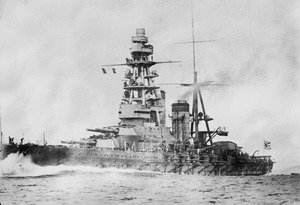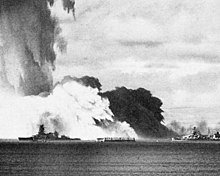The Nagato-class battleships (長門型戦艦 Nagato-gata senkan) were a pair of dreadnought battleships built for the Imperial Japanese Navy (IJN) during World War I, although they were not completed until after the end of the war. Nagato, the lead ship of the class, frequently served as a flagship. Both ships carried supplies for the survivors of the Great Kantō earthquake in 1923. They were modernized in 1933–36 with improvements to their armor and machinery and a rebuilt superstructure in the pagoda mast style. Nagato and her sister ship Mutsu briefly participated in the Second Sino-Japanese War in 1937 and Nagato was the flagship of Admiral Isoroku Yamamoto during the attack on Pearl Harbor on 7 December 1941 that began the Pacific War.
The sisters participated in the Battle of Midway in June 1942, although they did not see any combat. Mutsu saw more active service than her sister because she was not a flagship and participated in the Battle of the Eastern Solomons in August before returning to Japan in early 1943. One of Mutsu's aft magazines detonated in June, killing 1,121 crew and visitors and destroying the ship. The IJN conducted a perfunctory investigation into the cause of her loss and concluded that it was the work of a disgruntled crewmember. They dispersed the survivors in an attempt to conceal the sinking to keep up morale in Japan. Much of the wreck was salvaged after the war and many artifacts and relics are on display in Japan.
Nagato spent most of the first two years of the war training in home waters. She was transferred to Truk in mid-1943, but did not see any combat until the Battle of the Philippine Sea in mid-1944 when she was attacked by American aircraft. Nagato did not fire her main armament against enemy vessels until the Battle of Leyte Gulf in October 1944. She was lightly damaged during the battle and returned to Japan the following month for repairs. The IJN was running out of fuel by this time and decided not to fully repair her. Nagato was converted into a floating anti-aircraft platform and assigned to coastal defense duties. After the war, the ship was a target for U.S. nuclear weapon tests during Operation Crossroads in mid-1946. She survived the first test with little damage, but was sunk by the second test.

Nagato was selected to participate as a target ship in Operation Crossroads, a series of U.S. nuclear weapon tests held at Bikini Atoll in mid-1946. In mid-March, Nagato departed Yokosuka for Eniwetok, but her hull had not been repaired from the underwater damage sustained during the attack on 18 July and she leaked enough that her pumps could not keep up. The ship had a list of seven degrees to port by the time tugboats from Eniwetok arrived. She reached the atoll on 4 April and Bikini in May.[13]Operation Crossroads began with the first blast (Test Able), an air burst on 1 July 1946; Nagato was not close to ground zero and was only lightly damaged. For Test Baker, an underwater explosion, the ship was positioned closer to ground zero. Nagato rode out the tsunami of water from the explosion with little apparent damage; she had a slight starboard list of two degrees after the tsunami dissipated. A more thorough assessment could not be made because she was dangerously radioactive. Her list gradually increased over the next five days and she capsized during the night of 29/30 July.[49] Opened to divers in 1996,[62] The Times has named Nagato as one of the top 10 wreck divingsites in the world.[63]In 1970, salvage operations began on Mutsu's wreck that lasted until 1978 and recovered about 75% of the ship. The salvagers recovered bodies of 849 crewmen killed during the explosion. In 1995, the Mutsu Memorial Museum declared that no further salvage operations were planned. The only significant portion of the ship that remains is a 35-meter (114 ft 10 in) long section running from the bridge structure forward to the vicinity of No. 1 turret. The highest portion of the ship is 12 meters (39 ft 4 in) below the surface. Many, but not all, artifacts are displayed at the Mutsu Memorial Museum in Tōwa-Cho. Since 1963, a memorial service has been held there every year on 8 June in honor of the crew.[64]

Hi! I am a robot. I just upvoted you! I found similar content that readers might be interested in:
https://en.wikipedia.org/wiki/Nagato-class_battleship
Congratulations @kyleharuna! You have completed some achievement on Steemit and have been rewarded with new badge(s) :
Click on the badge to view your Board of Honor.
If you no longer want to receive notifications, reply to this comment with the word
STOPDo not miss the last post from @steemitboard!
Participate in the SteemitBoard World Cup Contest!
Collect World Cup badges and win free SBD
Support the Gold Sponsors of the contest: @good-karma and @lukestokes